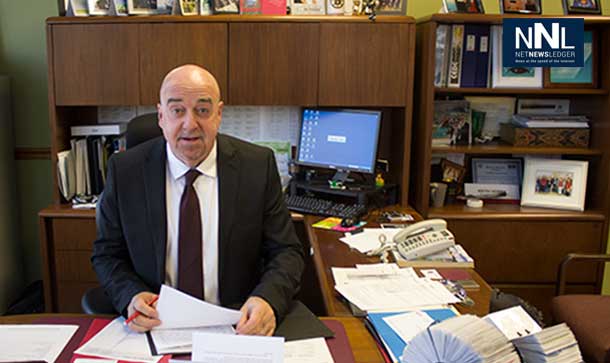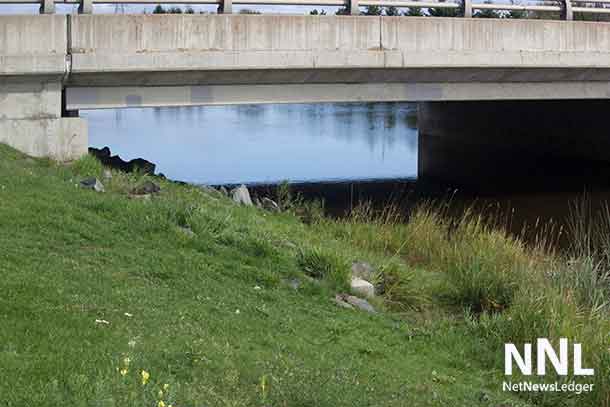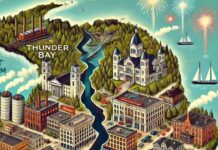
2013 Thunder Bay State of the City
THUNDER BAY – On behalf of the citizens of Thunder Bay and my colleagues on Council, I am pleased to bring greetings on behalf of the City of Thunder Bay which resides in the Robinson Superior Treaty and has been built on the traditional lands of the Ojibwa people of Fort William First Nation. I would also like to recognize the contributions made to our community by the Métis people.
I am proud to be here tonight to deliver the annual State of the City address.
Thunder Bay is undergoing a transformation. We are continuing to focus on the big, long‐term picture, with great, exciting opportunities on the horizon.
Let’s look back one hundred years. At about this time in 1913, construction on the Whalen Building in the heart of Port Arthur was being completed.
James Whalen commissioned the building as part of his quest to turn the Twin Cities into the ‘Chicago of the North,’ a place of strong physical buildings as well as opportunities for everyone.
The Whalen building still stands. It was built to last. It remains occupied to this day, housing many important offices, including those of Thunder Bay Hydro and the Community Economic Development Commission. They will be joined by Tourism Thunder Bay next year.
In short, the Whalen Building is a wonderful example of how important it is to honour that which came before, while continuing to plan for the future.
And it is important to note that the Whalen Building was constructed largely because of the dedication, vision and effort of Whalen himself.
President John F. Kennedy, a childhood hero of mine, once said, “things do not happen – things are made to happen.
That requires effort from all of us – city council, our citizens, our business community, city administration, and community agencies. All have something to contribute, and all play a key role in developing our City through working together.
We are fortunate to have such a dedicated citizenry in Thunder Bay. It has allowed us to do wonderful things together, which make our City a better place.
Today I want to talk about what is happening through two very different lenses – our physical infrastructure and our social infrastructure. In many ways, which I will speak about tonight, this Council has distinguished itself as the “Infrastructure Council,” or the council that is building a great City. Our roads, sewers, buildings, water mains, are critical to residents. We know they are top of mind from our citizen survey.
In 2013, this council approved a capital budget which will invest $64.6 million into the renewal of City infrastructure, both tax‐supported and rate‐ supported.
Our social infrastructure – our relationships and our focus on people and human services is also critical. We have put the spotlight on and made investments in social development like never before – by supporting the development of action plans and community partnerships to address crime, drugs, racism, poverty and more. As I’ve said before, social progress is a huge focus for this Council.
Both our physical and social infrastructure require focus and funding. Our investment in both is reflected in the City’s strategic plan and the actions taken by Council. Our credit rating was upgraded by Standard and Poor’s in both of the last two years. That’s important, because it brings down the cost of our borrowing. Our taxes and user fees are what support our programs, initiatives, services and projects. We all need to pay our fair share – and the City will continue to lobby other levels of government for fair and transparent models for all classes of taxpayers.
Sound financial planning based on a multi‐year view has been a hallmark of the City of Thunder Bay and that’s fortunate because it allows us to make things happen despite circumstances beyond our control like changes in funding programs or the global economy. A current challenge for this council is the manner in which industrial properties are assessed by the Municipal Property Assessment Corporation. MPAC’s decisions in this sector are increasingly arbitrary, anything but transparent, and having the effect of shifting more of the burden onto residential taxpayers. City Council will continue to fight hard to ensure all taxpayers pay their fair share.
Fortunately, our local economy continues to perform well. While it’s true the 2013 shipping season was slower than normal at the Port of Thunder Bay, the port is preparing for a good season next year on the strength of this fall’s grain harvest, which was the largest in Canadian history.
Our airport is on track for seven‐hundred and seventy thousand passengers through its terminal this year, which is a slight increase over the 2012 totals. Our tourism numbers are up, as well, with hotel occupancy rates hitting 81.9 per cent in September, the second‐highest in Ontario.
At the end of November, nearly 1,400 building permits had been issued with a construction value of more than $210 million which put us on track to match last year, which set a record at $216 million.
A number of big projects are underway such as Thunder Bay’s new Consolidated Courthouse, which will open in early 2014, and play a key role in revitalizing Thunder Bay’s south core. Great progress is being made on the new condominium and hotel buildings at Prince Arthur’s Landing, which will realize the vision of a mixed use development and put eyes on the park 24/7. Another big project, the Centre of Excellence for Integrated Seniors’ Services, is currently under construction.
In 2014 our housing starts are expected to surpass the 20‐year average for the City and our seller’s market persists, with housing prices rising 8.5 per cent this year.
Our City’s post‐secondary educational institutions, Confederation College and Lakehead University, continue to grow. Both remain very strong economic drivers for Thunder Bay, and play a major role in the development of our community.
Our wholly‐owned companies Tbaytel and Thunder Bay Hydro are also prospering. Tbaytel offers a complete bundle of products, and has begun implementing free public wi‐fi hotspots in Thunder Bay, a key part of our Smart City initiative. In 2013, Thunder Bay Hydro invested $4 million in solar generation projects, part of the company’s effort to build a legacy of renewable generation assets for our community.
Thunder Bay residents are taking notice, as well. Our 2013 citizen satisfaction survey showed that 92 per cent of citizens rate the overall quality of life in Thunder Bay as good. The survey also showed us that 89 per cent of respondents are satisfied with city services, and 75 per cent believe they receive good value for their tax dollars.
Now, let’s talk about physical infrastructure – our roads, sewers, facilities and water mains. These are critical assets and maintaining them is top‐of‐ mind for Thunder Bay’s citizens and council.
I am pleased to report that we are on track to close the infrastructure gap you have heard so much about. This is the difference between the annual cost of critical infrastructure upgrades and repairs and the funding available to do them.
Working alongside City administration, this council in 2014 will have doubled the City’s tax‐supported infrastructure spending in just four years. In large part, this is due to an additional $9.5 million invested per year in the Enhanced Infrastructure Renewal Program.
That funding increase has allowed us to better maintain our physical infrastructure, and we have several major projects planned for 2014 and 2015, including road upgrades to sections of May Street, Water Street, the Harbour Expressway, Broadway Avenue, Balmoral Street and Valley Street.
While our focus in recent years has been on roads, the long‐term infrastructure plan recently approved by council has identified storm water drainage and City facilities as major capital priorities over the next three years.
This vital work is also being accomplished with fiscally responsible tax increases. Taking the Enhanced Infrastructure Renewal Program into account, the average City tax levy increase over the last four years was slightly less than three per cent. Without the enhanced infrastructure funding, the average tax levy increase is just 1.7 per cent.
It is important to note that during this same time period, we have also realized annual net operating budget savings of $4.8 million. This has helped offset the increased investment in capital infrastructure.
Keeping on this track, the annual infrastructure gap could be closed by 2017. After that, we will be addressing the backlog; the good news is, we won’t be falling further behind.
I wish to take a moment to speak specifically about the ongoing Golf Links Road/Junot Avenue corridor project, which is a great example of how physical infrastructure can play a major role in City building.
In November, Phase One of the project was completed, which saw major work done to Golf Links Road between the Harbour Expressway and Oliver Road.
Over the course of seven months, beginning on a snowy May 1, that stretch was widened to four lanes, and an active transportation corridor, new trees and traffic lights were added at Central Avenue. The result of the phase one work is better traffic flow, easier access to area businesses and Innova Park, and smoother travel throughout the City.
Completing that project took hard work on the part of many people. Council needed to consider, debate and approve it, including the funding. Administration planned and oversaw the work of the contractors.
It also required patience on the part of our citizens and the area’s business owners, who were asked to find alternate routes and to slow down when driving through the area. They were asked to buy in, to keep the big picture in mind. We assured them that it would all be worth it in the end.
That proved to be true. It was worth it. Our patience and effort, our partnerships, were rewarded. Now, we’re ready to continue, with phase two beginning in 2014.
I wish to thank the Province of Ontario, Minister of Northern Development and Mines Michael Gravelle, and MPP Bill Mauro. Their support for the Golf Links Road project has been critical.
Golf Links Road is also important because it provides increased access to Innova Business Park, which is well‐positioned to host business operations of all kinds, including those in the resource sector.
The area plays a key role in our preparations for emerging opportunities in the region’s mining industry, which we continue to monitor closely as we work to implement our Mining Readiness Strategy, developed in partnership with the Community Economic Development Commission, Fort William First Nation, and a strong regional alliance.
The recent announcement that Cliffs Natural Resources is suspending its Ring of Fire development was unfortunate, but our region’s mining potential is much bigger than any one company. Several mines are due to enter the production phase in the next few years. The mining readiness strategy is a blueprint for making Thunder Bay a regional mining centre.
Work still needs to be done to ensure Thunder Bay can fill that role. We need to continue to lobby the provincial government to fulfill its obligations in the mining sector. Transportation infrastructure needs to be in place, training and employment opportunities created, and First Nation communities must be consulted and their treaty rights respected as projects move forward.
An adequate energy supply must be available, as well. We recently reached a major milestone in that process. In November, the province announced that it will convert the Thunder Bay Generating Station to burn biomass for energy.
It wasn’t quite the full conversion to natural gas we were hoping for, but the announced conversion, a pilot project, will keep the plant running for at least the next five years, and help us address some of the long‐term power supply concerns expressed by many people in the region.
By keeping that generating station running past Ontario’s coal deadline, we are ensuring a reliable energy supply for not only our residents, but major commercial and industrial operations, such as mines.
We will continue to support the work of the Energy Task Force. Normally, we don’t single out individual councillors in the State of the City address, but I believe my colleagues will understand why I wish to personally thank Councillors Iain Angus and Larry Hebert for their hard work on this vital issue.
Our inter‐governmental affairs committee has identified the future of the generating station as a priority, and we will continue to lobby the government to go ahead with the full conversion.
Our mining focus is just one way Thunder Bay continues to play a leadership role in the region. We work alongside such regional organizations as the Northwestern Ontario Municipal Association, lending our voice to theirs for the betterment of Northwestern Ontario as a whole.
This month, we attended the Northern Leaders Forum in Timmins, which brought together Northern mayors, First Nation representatives, and municipal representatives. It was an historic meeting, and we all pledged to work together for the betterment of the North.
We continue to investigate the potential for a new event centre. We are aggressively pursuing federal and provincial funding through the Inter‐ governmental Affairs Committee. We are also completing our review of the expressions of interest for private partners, and are looking at the future of the Fort William Gardens.We expect some exciting developments to come forward to council in the weeks and months to come.
We’re also striving to make our City cleaner and greener and more beautiful, starting work on a new anti‐litter strategy. Our EarthCare Advisory Committee is also working on a strategy to address climate change.
The EarthCare strategy is due for completion in the fall of 2014, and public input will be sought during the process.
The effects of climate change will also be a focus of the annual general meeting of the Great Lakes and St. Lawrence Seaway Cities Initiative, which Thunder Bay will host in June.
This initiative involves 108 mayors from around the Great Lakes Basin. While here, attendees will discuss how to improve the quality of life for the millions of people who live around the Great Lakes, on both the Canadian and American sides of the border.
While on the topic of climate change, I’d also like to take a moment to address the members of the Disaster Relief Committee. This year, the committee completed its mandate of administering the provincial disaster relief program here in Thunder Bay in response to last year’s flood disaster.
The work meant long hours and difficult decisions on the part of the committee, which was comprised entirely of volunteers. Thank you for your hard work, and for all you’ve done for our citizens. You helped many, many people who were in desperate need of assistance, and you have our gratitude.
We are also investing in physical infrastructure through the construction of two new fire halls, and also satellite EMS stations to provide more comprehensive coverage and improved emergency response times for our City.
Now, let’s talk about social infrastructure. President John F. Kennedy also said “Economic growth without social progress lets the great majority of people remain in poverty while a privileged few reap the benefits of rising abundance.”
A City is more than just roads and bridges, piers and buildings. A City is a community that must also provide the social infrastructure that gives citizens something to embrace, and be proud of. Social infrastructure is the glue that holds our society together. It is how communities and neighbourhoods are built, it’s the way citizens meet each other and develop friendships. It’s how we, as residents, grow to love our City and all it offers.
Building social infrastructure opens doors, helping to create a dynamic environment. The more things happen, the more traction Thunder Bay will build, attracting outside interest and investment. Possibilities.
Cities need people to thrive, and people need more than roads to build a life. They need opportunities, hope. A love for their City and what it offers – they need social infrastructure.
Prince Arthur’s Landing is a wonderful example of a project that is both physical and social. The area has been physically revitalized with new buildings, new businesses and new facilities. At the same time, Prince Arthur’s Landing is a gathering place for the community. Thousands and thousands of people visit the area each year, whether to skate in winter, cool off in the splash pad, enjoy the downtown district and all its great amenities, or simply take in the breathtaking views of the Sleeping Giant.
As we move ahead with Prince Arthur’s Landing, we are at the same time turning our attention to the rest of the City’s 52‐kilometre waterfront. We have been discussing some interesting possibilities for the next phase, such as an active transportation corridor along the lakeshore that connects the North and South ends of Thunder Bay. A new home for the Thunder Bay Art Gallery is another option. Again, both social and physical developments.
I’d also like to acknowledge the amazing work being done to build neighbourhoods and business areas all across Thunder Bay. We applaud those making such incredible efforts to improve our City, and are proud to support them whenever possible.
The Thunder Bay Chamber of Commerce, SHIFT, our BIAs, Evergreen, Our Kids Count, Thunder Bay Boys and Girls Club, and Neighbourhood to Build are just a few examples of the many that are working tirelessly.
Elsewhere in Thunder Bay, a proposed new youth centre is being discussed. The centre may well end up being one of several in collaboration with many partners including the Indian Friendship Centre, the Boys and Girls Club, Evergreen and others. Earlier this month, council was presented with a draft Thunder Bay Youth Strategy, one which seeks to empower all youth in our City.
The strategy calls for the creation of policies which increase access and participation by youth in recreation programs. It would also see a committee established to find ways to develop better options for program delivery, and investigate options for the creation of more youth centres in Thunder Bay.
We at the City also continue to support the implementation of several social and community development strategies, each of which brings something unique to Thunder Bay.
The Thunder Bay Drug Strategy continues working with the community to reduce the harms associated with substance use. It is evidence‐based. It is contributing to making our City and our citizens healthier.
The Drug Strategy earlier this year released its 2013 community report, which highlighted several major successes. Among those were the launch of the Superior and Thunder Bay Overdose Prevention Program.
The program supports individuals using opioids in a number of ways, including providing education on reducing the risks of overdose.
The Drug Strategy also played a key role in enhancing access to withdrawal services at the Balmoral Centre, which had been turning away about one thousand people per year over the last four years due to capacity issues.
The Balmoral Centre is hosting a pilot project, increasing access to to its twenty‐two crisis and stabilization beds, and adding 24‐hour nursing support. The pilot project will run until 2015.
It is no secret that substance use is a major issue for Thunder Bay. The enhancement of services at Balmoral Centre does not wholly address that issue, but it is a big step forward.
The expanded withdrawal service also reduces pressure on our emergency room, EMS workers and Police Officers, who currently spend an inordinate amount of time handling substance use matters. This is also important as we grapple with the rising costs of emergency services. Every little bit helps.
Another innovative project that addresses substance use issues is Shelter House’s managed alcohol program, which has received significant financial support from the City. The program has taken 15 of the most‐marginalized people off the streets, and has shown early success with reducing emergency and health‐care costs, and increasing quality of life for those receiving services. We are looking forward to seeing a full report on the managed alcohol program in early 2014.
Superior North EMS is taking steps to improve community health, as well, with its new community paramedic program.
The initiative will see paramedics provide community medical services like flu shots and helping to promote wellness and injury prevention initiatives in partnership with community agencies. It’s yet another example of the great work our EMS employees do daily under trying circumstances.
Our Crime Prevention Strategy continues to do important work to make our City safer through partnerships and collaboration. The Crime Prevention Council – which is made up of some 25 community agencies – recently launched its anti‐hate crime campaign titled Hate Divides a Community.
The council is also looking to expand the City Hall Sounds event after a very successful launch in summer of this year. City Hall Sounds invited citizens to the public space in front of City Hall for live music and great food once a week. Vibrant public spaces are a key component of crime prevention, and it was wonderful to see City Hall Sounds embraced by so many people.
Age Friendly Thunder Bay, meanwhile, continues to work to improve the independence and quality of life for our City’s senior population. Earlier this year, the group released a guide to help local businesses become more age friendly, and they continue to work in partnership with our local school boards to introduce our City’s youth to the age friendly initiative.
In the spring, a report will be presented to Council, which will highlight changes we can make in Thunder Bay to further increase independence and quality of life for our City’s seniors. I look forward to reviewing the report’s findings.
Elsewhere, members of the Crime Prevention Council continue to support grassroots work being done in our City’s neighbourhoods, and also introduced the respect campaign to Thunder Bay public schools in September.
Students are being treated to presentations on the respect campaign, which focus on the principles of respect, including celebrating diversity, respecting yourself and others, and knowing when to reach out for help. Respect will also be introduced to other community organizations in 2014.
The council also recently recognized another group of outstanding and inspiring citizens making a difference with the 2013 Mayor’s Community Safety Awards.
The crime prevention efforts being put forth by Thunder Bay Police and the Crime Prevention Council together with their community partners are proving successful. Crime is down in Thunder Bay, as is our City’s Crime Severity Index ranking.
I fully expect the new community policing model being adopted by the Thunder Bay Police, as well as the change to 12‐hour shifts, will make our City even safer.
I would like to take a moment to thank the brave men and women of the Thunder Bay Police Service for their dedication to the safety of our citizens. You are making a huge difference in our community.
Healthy local food is also important. The Thunder Bay and Area Food Strategy has officially launched, which is bringing together educators, farmers, representatives of the business and health care sectors, and others to develop ways to make healthy food accessible to everyone.
In October, the Poverty Reduction Strategy was presented to City Council. Completed by a steering committee made up of community partners, the strategy made twenty‐three recommendations to reduce poverty in our community, with a focus on housing, income, community economic development, infrastructure, inclusion and engagement.
This report was timely, as Thunder Bay is facing a critical shortage of housing. Our vacancy rate is very low. Citizens looking for affordable housing are encountering great difficulty in finding it.
For those who are homeless, the situation can be dire at this time of year. Shelter House is bursting at the seams on a nightly basis. Some are being required to sleep in the facility’s vestibule on cold nights,
Shelter House has teamed up with the Salvation Army to help address the issue through a cold weather pilot project, beginning this month, which will see eligible people moved from Shelter House to the Salvation Army to maximize the availability of beds.
We must continue to search for a permanent solution, however. That may involve lobbying other levels of government, or it may involve partnering with community agencies to develop more affordable housing options in our City. We cannot, and will not, let this matter fall by the wayside. This is not an issue that will be solved overnight, however.
In April of this year, the City commemorated the third anniversary of the adoption of the Aboriginal Liaison Strategy, which calls for Thunder Bay to work with the Aboriginal community to build an inclusive City that values diversity. Thunder Bay was the first city in Ontario to adopt an Aboriginal liaison strategy – we are immensely proud of that fact. Other municipalities are now looking to us as a model as they work to implement their own Aboriginal liaison strategies.
There are still issues to overcome, however. I wish to now take a moment to address one of those issues, which was recently in the spotlight.
In early November, a fire broke out at the James Street Swing Bridge. This is the main route of travel between the City of Thunder Bay and Fort William First Nation. I would like to thank the Thunder Bay Fire and Rescue personnel for their professional response and quick action in extinguishing this blaze.
In addition to the travel concerns this fire caused, it also brought out the worst in some people. During the fire, and in the days following, racist comments and jokes were made by some, and such behavior cannot be tolerated. It absolutely flies in the face of the work we at City Hall are doing with our community partners.
Nelson Mandela showed the world an example of the power of respect. “No one is born hating another person because of the colour of his skin, or his background, or his religion,” Mandela once said. “People learn to hate, and if they can learn to hate, they can be taught to love, for love comes more naturally to the human heart than its opposite.”
We still have much work to do on this issue through our Anti‐Racism Committee. However, it is important to note that those making the innpropriate jokes and remarks are in the minority, and despite their attitudes, our City’s relationship with Fort William First Nation remains strong. We must continue to foster that relationship through building partnerships and focusing on respect. Doing so will make both of our communities stronger.
We, as your City Council, don’t exist in a bubble. We are dependent on each other, and I wish to thank my fellow council members for the work you do, and for your dedication to your community and those who live here.
Part of your job, unfortunately, is to endure criticism. I have to say, since I stepped into the role of Mayor, I have seen nothing but hard work and a passion to deliver our strategic plan from each and every one of you. I am proud to serve daily with you.
I wish to also thank the members of our City’s administration. In our municipal government, our Council members set the priorities and approve the projects. Administration develops and implements the action plans to make all this work possible, including the social development initiatives.
Although we are involved in many projects and initiatives, it is important to remember that overall, the City is in good financial shape with a strong balance sheet. We are increasingly doing multi‐year planning and, on important social issues, we are working in partnership with the community to build capacity and share in the necessary funding. We are taking a leadership position, but we are focused on being part of a team.
I’d also like to thank our City’s front‐line employees for all you do. Not only do you play a key role in the day‐to‐day operations of Thunder Bay, but in many cases, you’re the point of contact for our citizens. Thank you for performing your duties with such passion and dedication.
Thank you, as well, to Thunder Bay’s media for not only promoting the City of Thunder Bay, but also enduring council meetings in the process. You are a vital link to our citizens, and play an important part in educating them on what we do.
Last, but certainly not least, thank you to our citizens. Thank you for continuing to show such interest in what happens here in Council chambers, as well as out in the community. Our City is strong precisely because we have so many engaged and informed citizens.
We may not always see eye‐to‐eye on specific issues, but that, I believe, is the hallmark of a democratic system. We can all be proud of the fact that, by working together, we’ve made this City a better place. We’ve honoured what came before, but kept our focus on the future. Just like James Whalen did 100 years ago.
Thank you all for your work in making Thunder Bay the best City it can be.
In closing, I would like to wish all our citizens a very Merry Christmas and Holiday Season, and all the best for a safe and prosperous 2014.
Thank you.
Mayor Keith Hobbs






